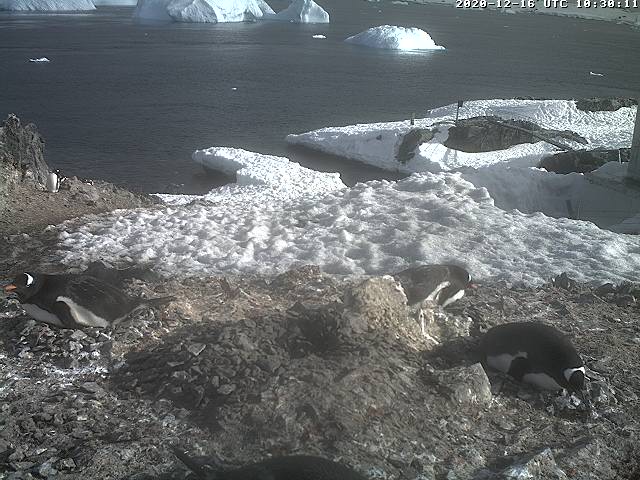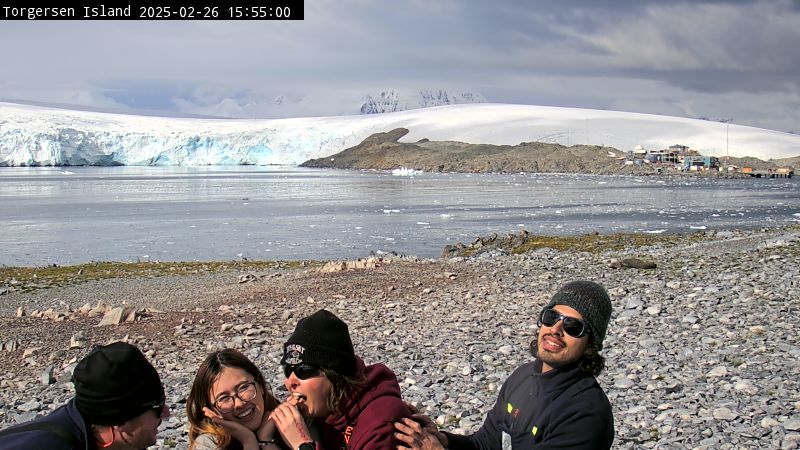
During the day, half of the Gentoo pairs leave for feeding. In the meantime, the other partner keeps the nest warm, or the eggs, as the case may be. Hopefully we will see our RM and JC with eggs soon.
But what do we know about these magnificent birds? I found a marvelous no-nonsense site that delivers on the information re: penguins, and many other animals who make the oceans their home. It is MarineBio.org and their work has far reaching positive effects for marine and terrestrial life.
Citation:
| Pygoscelis papua, Gentoo Penguin - MarineBio.org. Retrieved Sunday, November 25, 2007, from http://marinebio.org/species.asp?id=650. |
 Pygoscelis papua
Pygoscelis papuaGentoo Penguin
Description & Behavior
The gentoo penguin, Pygoscelis papua (Forster, 1781), is another Antarctic penguin species first described by Johann Reinhold Forster, an explorer and naturalist who accompanied Captain Cook on his late 18th century voyages. Gentoo penguins are small birds standing about 80 cm tall and weighing an average of 5 kg. They have black plumage on the back and head with a white band that runs across the crown of the head from eye to eye. They have a bright orange bill and orange feet.
The gentoo is the fastest swimming of all penguin species reaching speeds of up to 36 kph as well as one of the rarest.
World Range & Habitat
Gentoo penguin, Pygoscelis papua, breeding sites are found on sandy or stony beaches on the Antarctic peninsula and around the Crozet, Falkland, Macquarie, Prince Edward, South Georgia, South Orkney and South Sandwich islands.
Although gentoos return to the same breeding area each year, they tend to move their sites away from previous sites because of the guano (collected droppings of seabirds) that accumulates during the breeding season. Some colonies have been observed returning to the same site year after year only to suddenly move to an entirely new site several kilometers away. The reason for these moves is unknown. Colonies are typically small, consisting of a few 100 breeding pairs and breaking into subcolonies when colonies become too large.
Feeding Behavior (Ecology)
Gentoo penguins, Pygoscelis papua, forage close to shore, diving to average depths between 20-100 m, although in some cases they have been recorded diving to 200 m. A gentoo will dive up to 450 times per day to forage. They feed on small fish, crustaceans and squid.On land, they have no predators, but skuas (pictured above), gulls and other sea birds will prey on unattended eggs and small chicks.
Life History
Gentoo penguins, Pygoscelis papua, breed in rookeries or colonies and make nests from a variety of materials including feathers, grass, rocks and twigs. Females lay 2 eggs in late October that are incubated by both parents for about 1 month. Although eggs are laid as much as 4 days apart, they hatch within 24 hours of each other. Both parents brood the 2 chicks, alternating daily to feed and protect them. The chicks remain in the nest until they have their adult plumage when they are between 3-4 weeks of age. Adults alternate foraging daily, typically traveling within 20 km of the breeding site. As the chicks grow, they form large crèches (chicks are left in groups while both parents forage). Although chicks fledge around 3 months of age, the parents continue to feed them for several weeks. Following breeding season, gentoos return to the open ocean to forage prior to their annual molting season, which lasts for 2-3 weeks.
Comments
Because of shortages in gentoo penguin prey around the Falkland Islands, thousands of birds have died of starvation during their annual molting season. Diminished prey availability is likely due to overfishing, however the government of the Falkland Islands has thus far been unwilling to implement fishing bans near gentoo penguin habitat so the future of gentoos in that area is uncertain.
Gentoo penguins, Pygoscelis papua, are listed as Near Threatened (NT) on the IUCN Red List of Threatened Species:
NEAR THREATENED (NT)
A taxon is Near Threatened when it has been evaluated against the criteria but does not qualify for Critically Endangered, Endangered or Vulnerable now, but is close to qualifying for or is likely to qualify for a threatened category in the near future.
| Further Research | ^ back to top |
| References | [Edit Species] |
| Integrated Taxonomic Information System (ITIS): Pygoscelis papua FIGIS - FAO/SIDP Species Identification Sheet: Pygoscelis papua FishBase Species Summary: Pygoscelis papua | LarvalBase Species Summary Pygoscelis papua: Animal Diversity Web, University of Michigan Museum of Zoology Gentoo Penguin, Pygoscelis papua - International Penguin Conservation Working Group - Seabirds.org Falklands Penguins Starve to Death - International Penguin Conservation Working Group The Complete Photographic Guide to Birds of the World, Marcus G. Martin's Bird Photo Gallery - Photobirder.com Gentoo Penguin, Wikipedia Bird Information Web Site, Antarctica, North America - www.birdinfo.com |


.jpg)





















No comments:
Post a Comment